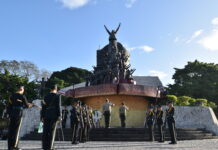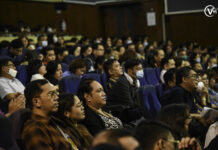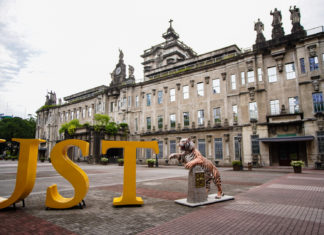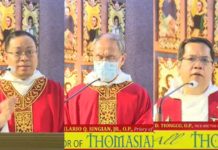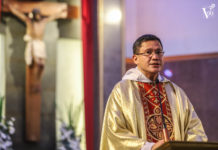STARTING this semester, the UST administration is providing Thomasians with a new digital identification system.
While La Salle and Mapua have been using a similar system for years, it is only now that UST is upgrading its identification system—one of the few steps towards full computerization of facilities.
Being an open campus, the University has always had the problem of outsiders getting into student-designated areas.
According to Fr. Winston Cabading, O.P., UST Secretary-General and director of the Computer Center, the digital IDs are mainly for security purposes. They also determine whether a student is enrolled or not.
Former students, for example, still use their old IDs to get inside buildings. Alumni are made to apply for the alumni card which serves as their ticket in.
In addition, parents can also know where their child is in emergency situations.
“Kunyaring may nangyaring accident, pinapatanong ng parents kung nasaan na siya (student). It will be easy for us to say that your child entered this building at this time.” Cabading said.
This is made possible by the installation of locators and card readers at the entrance of buildings. Public places like parks, the parish chapel, and the hospital are not covered.
The ID will be passed over the reader, which reads information like the name, college, and student number contained in the microchip embedded in the ID and shown on a screen. The information on the chip may also include past violations of rules.
The database will be handled by the ORACLE system and the German company ACG Identification Technology will supply the cards through Unlimited Solutions Corp., its local distributor.
New system
The idea of having a digital ID has been in the minds of administrators for more than a year. They toyed with the idea at first, not fully aware of the potential of the card.
“We decided to adopt the digital ID because the students wanted it. We asked them (students, in a survey) last January, when Unlimited Solutions demonstrated how the digital ID works, if they wanted the digital ID and they said yes.” Cabading said.
The survey was done in the lobby of the Main building during a demonstration by Unlimited Solutions during the University Week. Students walking nearby were given survey forms and they could opt to answer or not.
Nonetheless, Cabading refused to furnish the Varsitarian a copy of the survey. According to him, the survey data are kept confidential since they contain the names of the students.
The Varsitarian was able to acquire a copy of the tally sheet from the Computer Center. The survey was done between Jan. 29 to 31, Feb. 1 and 4 to 8. There were a total of 378, respondents including 11 VIPs and 30 guests from other schools from Jan. 29 to Feb. 8. Majority of the respondents came from the 2nd to the 4th years. Cabading added that some from the 4th year did not answer because the new system would not cover them. UST has a total population of 32,205 students.
Interestingly, there were also respondents from other schools. Fr. Cabading said that Unlimited Solutions invited students from other schools so that they could see the demonstration. He also said that UST also invited Mapua to show the Computer Center how the system works.
However, not all students will have a taste of the new system. Graduating students will not be required to have digital IDs.
According to Prof. Perla Cosme, assistant director of the Computer Center, they only included students up to the 3rd year because the Computer Center can only develop at least three-fourths of the application.
“Mao-optimize yung use, so pagkagraduate nung bata, masasabi niyang nagamit niya nang husto iyong digital ID niya. Kasi yung mga 4th year, di na nila mae-enjoy, kaya di na namin sila isinama.”
But those who want to avail of the system must pay an extra fee of P300 to have their current IDs converted.
The initial plan was to implement the new system once everything is ready in 2006. But due to popular demand and the availability of the technology, the administration has introduced the system this year.
High tech, high cost
So far, the only drawback of this ID is its high cost. The fee for students is P300, paid upon enrollment. This covers the freshmen, transferees, and shifters. In the old system, a student only had to pay P60 to get a replacement ID. This time, the student must shell out P400 to get a replacement.
According to Assistant Director for Networking Beatrice Lacsamana, the ID is expensive because it is chip-based and imported from Germany. The cost ranges from about five to ten American dollars.
Lacsamana said that they chose ACG because they wanted to provide the students with high-quality ID, unlike those made in China that have been going around and used by other universities which easily tear.
“(The price for the ID replacement is high) because if there is no penalty, the students will not care if they lose their ID,” she said.
To prevent students from destroying or dismantling their IDs, informative notices will be put up in bulletin boards explaining their proper handling.
The digital readers, which cost about $1,000 per unit, and the maintenance costs will be shouldered by the administration. The machines are under warranty for a year.
Asked the total cost of the system, Fr. Cabading said that the amount cannot be revealed because the administration signed a contract not to mention it in consideration of the special price that UST was given. He added that the university got a discount because of the sheer volume of its students.
More special features
The new IDs are not merely locators and library cards. The Computer Center will also make it possible for students to view their grades in kiosks that they are planning to build.
In summary, there will be a total of 16 applications, including the locator, that will be incorporated in the ID. One of those applications, although still in the planning stage, is the use of the ID as an “E-purse” or electronic purse. Similar to Smart Money card, this feature will allow students to make purchases using the ID.
In spite of its hi-tech features, the card still has the characteristics of a regular ID. The front will bear the picture, name, college, and student number of the student in case there will be some computer difficulties. The Computer Center will take charge of the maintenance and replacement of the computers if problems arise.
Reactions
Student activists complained that the new system is also another financial burden to the students. It could also be an invasion of the privacy of the students.
Romulo Yumul of the Alliance of Concerned Thomasians said that the digital ID could be compared to the proposed National ID system. He said that vital information about the student is contained inside the ID. With the use of the locator, the administration could monitor the activities of activist students.. Yumul said that the administration should focus instead on giving the students quality education.
Student activists say they will oppose the new ID. Students will always be students, even if they are activists. Fr. Cabading said. Even if they organize rallies, as long as they don’t violate anything in the student handbook, the administration can not prevent them from entering the buildings, the office said
“The digital ID is never intended to be a tool of harassment,” Fr. Cabading said.
Lacsamana quelled fears about the ID as a tool for discrimination and invasion of privacy. It is meant to provide better service.
“Definitely, pag may kaso yung bata, hindi doon lalabas sa screen. (pero) Kung may tawag sa bahay, may nangyari, lalabas doon ‘please go to the Office for Student Affairs’,” she said.
Computers will be precalibrated for hackers. For a “two-way security,” students will be able to log-in with passwords. The data contained in the ID will be “read- only.”
Back-ups will be provided as safeguards. The Center is also counting on the Uninterruptable Power Source (UPS) hardware that will provide reserve power for 30 minutes when computers shut down to prevent data loss.
Lacsamana declined to give further details because of the security policy. But she admitted that those working on the Computer Center will be able to see the student records. She assured the students that the staff will keep the information confidential.
With reports from Jennifer B. Fortuno and Maria Pacita C. Joson


